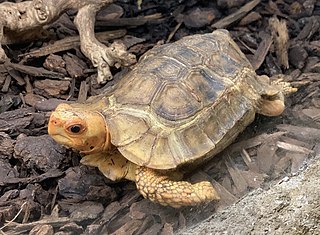
Holaspis is a genus of equatorial African lizards in the family Lacertidae. These lizards are capable of gliding flight for distances of 30 meters.

Vittorio Bottego was an Italian army officer and one of the first Western explorers of Jubaland in the Horn of Africa, where he led two expeditions. He was an artillery captain in the Italian Army.

The keeled box turtle is a species of turtle in the family Geoemydidae. The species is endemic to Asia.

Bitis inornata is a venomous viper species found only in Cape Province, South Africa. No subspecies are currently recognized.

Pelusios is a genus of African side-necked turtles. With 17 described species, it is one of the most diverse genera of the turtle order (Testudines).

The forest hinge-back tortoise, also known commonly as the serrated hinge-back tortoise or Schweigger's tortoise, is a species of tortoise in the family Testudinidae. The species is indigenous to the tropical forests and marshes of central and western Africa.

Home's hinge-back tortoise is a species of tortoise in the family Testudinidae. The species is endemic to Africa.
The variable mud turtle, also known as Rhodesian mud turtle, Mashona hinged terrapin or variable hinged terrapin, is a species of turtle in the family Pelomedusidae. It is widely distributed in Central, East, and Southern Africa. The species was officially described by John Hewitt in 1927 and had to be broken into subspecies due to color variations on the heads of the turtles acrost the regions.

The East African black mud turtle, also known as the Pan terrapin, is a species of turtle in the family Pelomedusidae, native to eastern and southeastern Africa.

Terrapins are one of several small species of turtle living in fresh or brackish water. Terrapins do not form a taxonomic unit and may not be closely related. Many belong to the families Geoemydidae and Emydidae.

August Friedrich Schweigger was a German naturalist born in Erlangen. He was the younger brother of scientist Johann Salomo Christoph Schweigger (1779-1857).

The West African mud turtle, also known as the West African side-necked turtle or swamp terrapin, is a species of turtle in the family Pelomedusidae. Pelusios castaneus is a freshwater species and is endemic to West and Central Africa.

The Okavango mud turtle or Okavango terrapin) is a species of turtle in the family Pelomedusidae endemic to Africa. It is found in Angola, Botswana, the Democratic Republic of the Congo, Namibia (Caprivi), Zambia, and Zimbabwe.
The short racer, is a species of snake in the family Colubridae. The species is endemic to northeastern Africa.

The large-eyed green tree snake, also known commonly as the splendid dagger-tooth tree snake, is a species of venomous snake in the family Colubridae. The species is endemic to Africa. There are three recognized subspecies.
Amplorhinus multimaculatus, commonly known as the many-spotted snake or the Cape reed snake, is a species of mildly venomous snake in the family Pseudoxyrhophiidae. The species, which is native to southern Africa, is monotypic in the genus Amplorhinus.

Chalcides bottegi, also known commonly as Bottego's cylindrical skink or the ocellated skink, is a species of lizard in the family Scincidae. The species is native to East Africa, the Horn of Africa, and Northeast Africa.

Agama bottegi, also known commonly as the Somali agama, is a species of lizard in the family Agamidae. The species is endemic to Somalia.

Elapsoidea sundevallii, also known commonly as Sundevall's garter snake or African garter snake, is a species of venomous snake in the family Elapidae. The species is native to Southern Africa. There are five recognised subspecies.
















